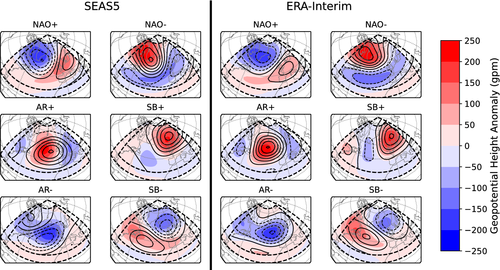A new paper has been published in the Quarterly Journal of the Royal Meteorological Society by MPE Reading Student, Swinda Falkena.
Authors: Swinda K.J. Falkena, Jana de Wiljes, Antje Weisheimer, Theodore G. Shepherd
The paper can be viewed online here: https://rmets.onlinelibrary.wiley.com/doi/10.1002/qj.4213
Abstract
To study the forced variability of atmospheric circulation regimes, the use of model ensembles is often necessary for identifying statistically significant signals as the observed data constitute a small sample and are thus strongly affected by the noise associated with sampling uncertainty. However, the regime representation is itself affected by noise within the atmosphere, which can make it difficult to detect robust signals. To this end we employ a regularised k-means clustering algorithm to better identify the signal in a model ensemble. The approach allows for the identification of six regimes for the wintertime Euro-Atlantic sector and leads to more pronounced regime dynamics, compared to results without regularisation, both overall and on sub-seasonal and interannual time-scales. We find that sub-seasonal variability in the regime occurrence rates is mainly explained by changes in the seasonal cycle of the mean climatology. On interannual time-scales relations between the occurrence rates of the regimes and the El Niño Southern Oscillation (ENSO) are identified. The use of six regimes captures a more detailed response of the circulation to ENSO compared to the common use of four regimes. Predictable signals in occurrence rate on interannual time-scales are found for the two zonal flow regimes, namely a regime consisting of a negative geopotential height anomaly over the Norwegian Sea and Scandinavia, and the positive phase of the NAO. The signal strength for these regimes is comparable between observations and model, in contrast to that of the NAO-index where the signal strength in the observations is underestimated by a factor of 2 in the model. Our regime analysis suggests that this signal-to-noise problem for the NAO-index is primarily related to those atmospheric flow patterns associated with the negative NAO-index as we find poor predictability for the corresponding NAO−− regime.

Key to FIGURE above: The regimes identified for the ECMWF SEAS5 hindcast ensemble members (left) and ERA-Interim (right) using standard k-means clustering for two slightly different domains (indicated by the dashed boxes). They are the positive and negative phases of the North Atlantic Oscillation (NAO), the Atlantic Ridge (AR+) and its negative counterpart (AR−−), and the Scandinavian Blocking (SB+) and its negative counterpart (SB−−). Regimes for domain A (20–80°N, 90°W–30°E) are indicated by the colours and those for domain B (30–90°N, 80°W–40°E) by the contours, following the same 50 gpm difference between contour levels.






